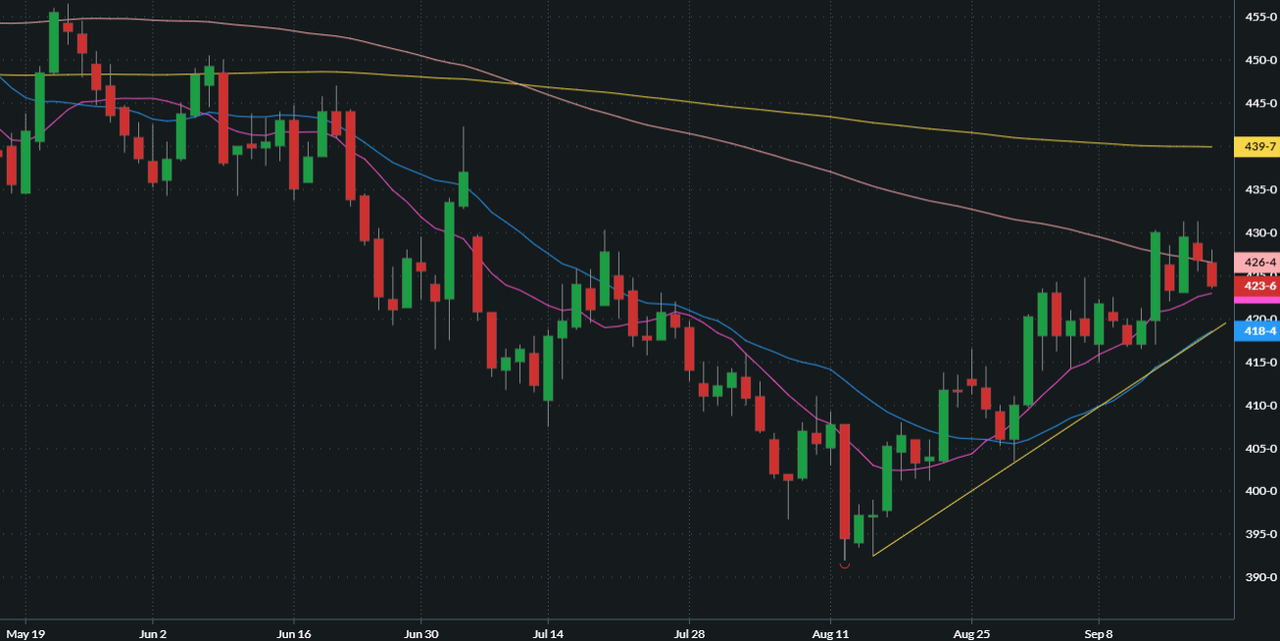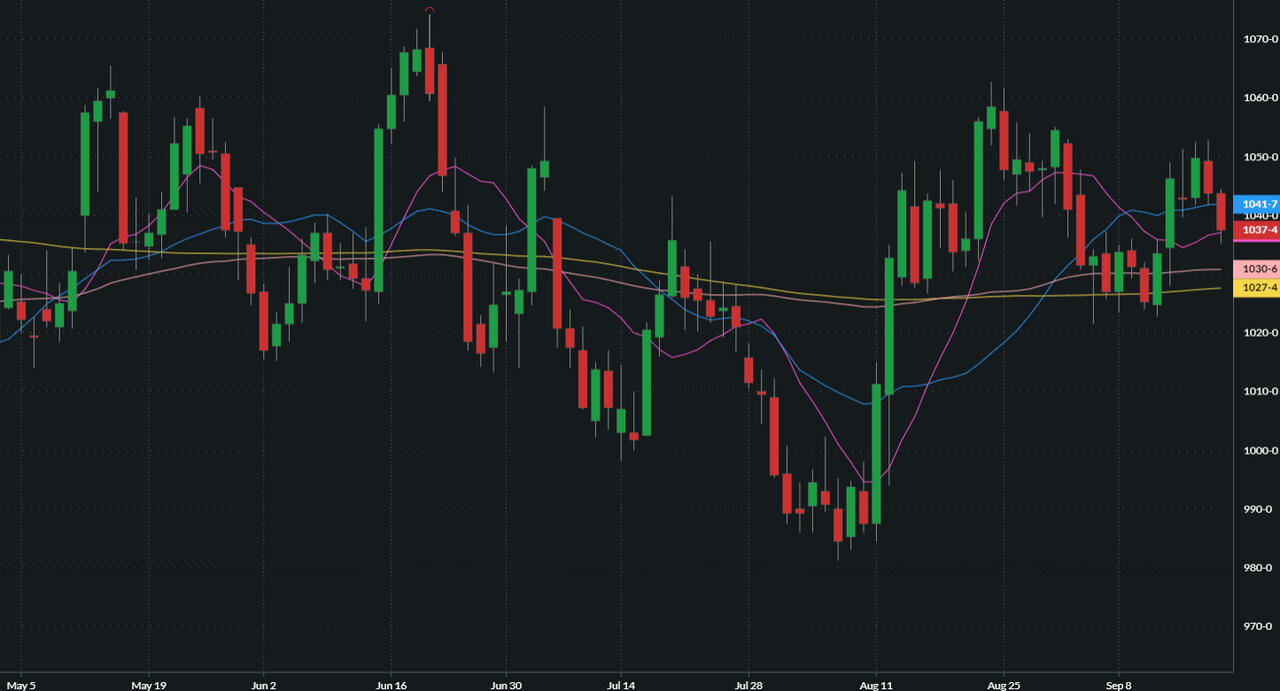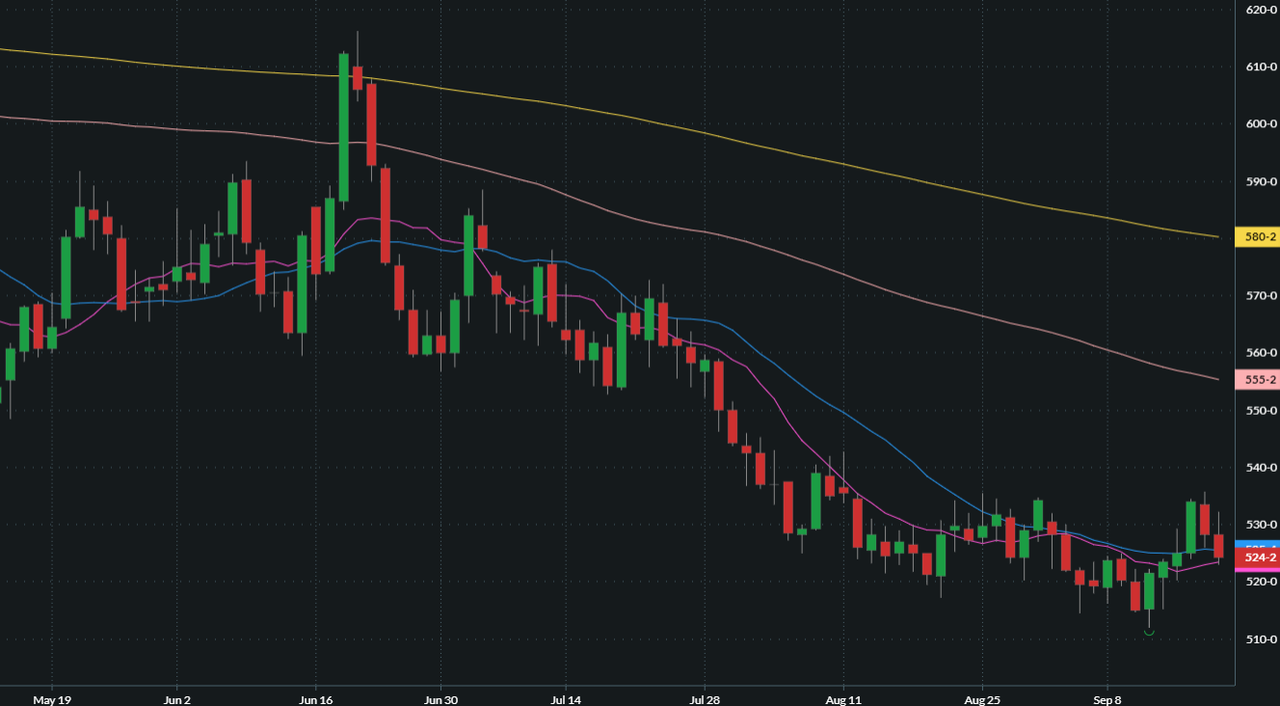Don’t miss the latest market commentary from the Farm Futures team. Sign up for the complimentary morning and afternoon market newsletters!
Prices updated as of 6:55 a.m. CDT.
What we’re watching
The corn market’s continued rally despite bearish USDA data reflects a simple truth: “We do not have a clue where corn yield is going to end up until harvest is done,” Total Farm Marketing’s Naomi Blohm says. Southern rust and other maladies may be taking a toll. Read Blohm’s latest Ag Marketing IQ post as she details four lower-yield scenarios and potential supply implications.
Corn supported by strong exports
December corn rose 1.5 cents to $4.2525 per bushel late in overnight trading after easing 3 cents Thursday to $4.2375, a second consecutive daily decline. Futures are down from $4.30 at the end of last week.
The corn market’s recent rally lost some momentum this week as December futures ran into resistance just above $4.30, an area that has generated farmer selling in both the U.S. and Brazil, according to reports. Depending on the strength or weakness of today’s close, prices may extend sideways consolidation next week as traders monitor early harvest results.
December futures continue to hold above key chart levels including the 10-day simple moving average (SMA), currently about $4.2350 and this week’s low at $4.22. Prices are also about 6 cents above an uptrend line drawn from the contract low at $3.92 posted August 12. Near-term resistance includes a 10-week intraday high at $4.3125 posted Tuesday and matched Wednesday.
Barchart’s front-month national average cash corn price fell about 3 cents Thursday to $3.7925.

Corn futures retain support on expectations a late-summer dry spell in parts of the Midwest, along with crop ailments including southern rust, have crimped yield potential. Rainfall is expected to sweep across much of the Midwest this weekend, and while temperatures may remain warm, longer-term forecasts call for stronger precipitation prospects.
In USDA’s Crop Production report last Friday, the agency lowered its average U.S. yield estimate by 2.1 bushels per acre to 186.7 bpa and hiked production to a record 16.814 billion bushels. But those numbers may drop in subsequent reports as more harvest data is gathered.
USDA’s weekly export sales data continued to reflect strong demand from Mexico and other top buyers. Net U.S. corn sales for 2025-26 delivery totaled 1.232 million metric tons (48.5 million bushels) during the week ended September 11, up 45% from the same week a year earlier. Sales were around the middle of trade expectations, and Mexico again led buyers with purchases totaling 419,200 metric tons.
Corn sales commitments so far in 2025-26 (including accumulated exports) now total 938.3 million bushels, up 68% from the same period in 2024-25 and almost 32% of USDA’s full-year export estimate for a record 2.975 billion bushels.
Also Thursday, USDA reported private exporter corn sales of 110,000 MT (4.33 million bushels) of corn for delivery to Mexico during the 2025-26 marketing year.
Elsewhere, Brazil’s Conab estimated the country’s 2025-26 corn crop at 138.28 MMT (5.44 billion bushels), which would be down 1.42 MMT, or 1%, from 2024-25. Acreage is expected to increase by 770,000 hectares (1.9 million acres) to 22.63 million hectares (55.92 million acres).
Soybean market watching trade talks
November soybeans rose 4 cents to $10.4150 late overnight after sinking 6.25 cents Thursday to $10.3750, the contract’s lowest close since September 11. Futures are down from $10.4625 at the end of last week and on track for a third weekly decline in the past four weeks.
Soybeans posted a modest corrective rebound overnight following two days of losses, with November futures holding initial support at the 10-day SMA ($10.3850) and climbing back above the 20-day SMA ($10.41). While technicals softened this week, prices remain around the middle of the past month’s trading range (roughly $10.21 to $10.63) and could see further sideways consolidation in coming days as traders monitor harvest and trade developments.
Longer-term, November futures may be forming a “bull flag” on the daily bar chart drawn from the four-month low of $9.8125 reached in early August. Upside levels to watch include this week’s intraday high at $10.5275.
Barchart’s front-month national average cash soybean price fell about 6 cents Thursday to $9.61.

December soybean meal rose $1.60 to $286.30 per ton after shedding 0.4% Thursday to end near a two-week low. December soyoil fell 11 points to 51.02 cents per pound after tumbling 1.3% Thursday to its lowest close in over a week.
Some of the pressure on soybeans this week stemmed from weakness in soyoil, which fell on concern over a lack of specifics from the government on long-term U.S. biofuels policy. Traders are “disappointed that we’ll likely not have clarity on our biofuel program until late November or December, limiting biomass diesel production in the meantime,” StoneX analyst Arlan Suderman said in a note.
China’s absence from the U.S. soybean market amid ongoing trade tensions has also burdened prices. The world’s biggest soybean importer has yet to buy any beans from the U.S. for the new-crop year. Traders will be watching for any progress on trade negotiations with President Trump and Chinese President Xi Jinping are expected to speak over the phone today.
“Sky-high reciprocal U.S.-China tariffs will resume in mid-November should the two sides fail to reach an agreement by then,” Zaner Ag Hedge Chief Market Analyst Karen Braun said in a report. “For now, China has plenty of beans arriving, another reason it may be able to delay U.S. purchases until November or later.”
In last Friday’s Supply and Demand update, USDA lowered its 2025-26 soybean export estimate for a third consecutive month, dropping it another 1.2% to 1.685 billion bushels, and further reductions are possible if China remains out of the U.S. market.
USDA’s weekly export sales update showed new-crop soybean purchases continued to lag, exacerbating worries of the absence of Chinese buying.
Net soybean sales for 2025-26 delivery totaled 923,000 MT (33.9 million bushels) during the week ended September 11, around the middle of trade expectations but down 47% from the same week in 2024. Egypt led buyers at 228,400 MT, followed by Mexico at 195,400 MT. China was again not specifically named as a soybean buyer.
For 2025-26 to date, U.S. soybean export sales (including accumulated exports) now total 377.6 million bushels, down 36% from the same period in 2024-25 and a 17-year low for this time of year, according to Suderman. A week ago, USDA said it lowered its 2025-26 export forecast by 20 million bushels to 1.685 billion bushels, down 10% from 2024-25.
Elsewhere, Conab estimated Brazil’s 2025-26 soybean crop at 177.67 MMT (6.53 billion bushels), up 3.6% from 171.47 MMT in 2024-25 and a reflection of expectations for higher planted area. Plantings are expected to increase 1.73 million hectares, or almost 4%, from last year to 49.08 million hectares (121.28 million acres).
Wheat export pace slowing
December SRW wheat futures rose 0.75 cent to $5.25 late overnight after dropping 4 cents Thursday to $5.2425, the contract’s second consecutive daily decline. Futures are still up from $5.2350 at the end of last week and could mark a second consecutive weekly advance.
Despite the past two days of price weakness, wheat futures have offered some indications of establishing a near-term bottom. December SRW futures are up about 13 cents from a contract low at $5.12 hit a week ago and are hovering just above the 10-day SMA ($5.24). Downside levels to watch include $5.04, a five-year low for a most-active SRW futures posted August 6.
December HRW futures were unchanged at $5.10 after falling 6.25 cents Thursday to end at a one-week low. December spring wheat rose 1.5 cents to $5.7325.

While prices have rebounded modestly, wheat retains limited upside potential amid ample domestic and global supplies. The soon-to-be-finished spring wheat harvest is pushing fresh supplies into the pipeline, and USDA’s global Supply and Demand numbers last Friday leaned bearish.
U.S. wheat exports continue to exceed last year’s levels even though the pace has slowed in recent weeks. USDA reported net U.S. wheat sales for 2025-26 delivery at 377,500 MT (13.9 million bushels), up 24% from the previous week but down 12% from the average for the previous four weeks. Sales were at the low end of expectations. The Philippines was the top buyer at 186,000 MT.
For 2025-26 to date, U.S. wheat export sales (including accumulated exports) now total 481.3 million bushels, up almost 21% from the same period in 2024-25 and 53% of USDA’s full-year estimate for 900 million bushels (in last week’s Supply and Demand report, USDA hiked its 2025-26 export forecast by 25 million bushels).
Wet weekend ahead for the Midwest
Much of the Midwest will receive rainfall over the weekend and early next week, with 0.25 inch to 1.5 inches possible across a band stretching from the eastern halves of Nebraska and Kansas northward into Illinois and Wisconsin, based on NOAA’s latest 72-hour cumulative precipitation map. Indiana and Ohio, among the driest areas in the Corn Belt, may receive trace amounts to 0.5 inch.
Above-normal temperatures are expected to persist the rest of the month and into early October, though moisture chances have improved, based on the National Weather Service’s 6-to-10-day and 8-to-14-day outlooks. The 6-to-10 day outlook, which covers September 24-28, shows above-normal precipitation prospects expanding from the Southeast into the eastern and central Corn Belt.
Stocks closing out record Fed-driven week
Stock index futures were little changed in overnight trading a day after the major averages extended a record rally in the wake of the Federal Reserve’s interest rate cut earlier this week.
Futures based on the S&P 500 and Nasdaq-100 indexes were up less than 0.1% while futures based on the Dow industrials were little changed. The underlying S&P 500 closed at a record near 6,632 on Thursday and is up 2.7% so far this month. The Dow industrials and Nasdaq Composite also recorded records.
The U.S. dollar index was up 0.3% as the benchmark continued a modest rebound after sinking to a 3-1/2-year low Wednesday. November WTI crude oil futures rose 32 cents to $62.94 per barrel. Gold futures gained 0.2% and remain near Wednesday’s record above $3,700 per ounce.
What else I’m reading at www.FarmFutures.com this morning:
- If you’ve got southern rust on your corn, you’ve got a dirty job ahead. Best to tackle it early and harvest affected fields first, says Wallaces Farmer Editor Gil Gullickson.